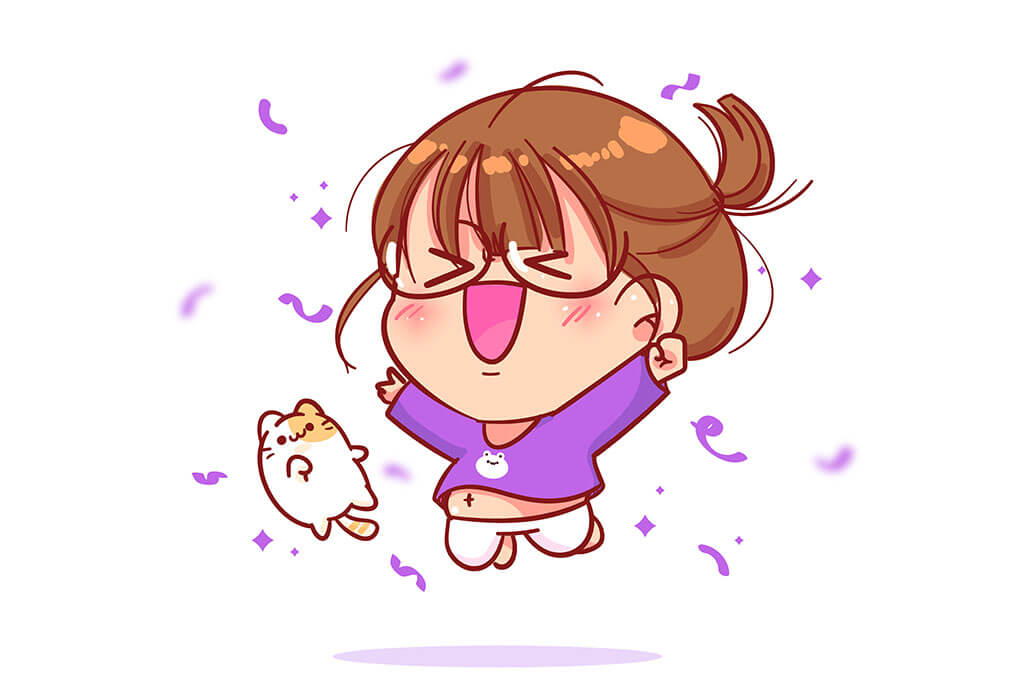To say “happy” in Japanese, there are two common words you should know. These are, 嬉しい (ureshii) and 幸せ (shiawase).
The former, 嬉しい (ureshii), is the best and most common way to say “happy” in Japanese.
嬉しい (ureshii) is purely an adjective that is very easy to use as pronouns in Japanese are frequently omitted. By simply saying 嬉しい (ureshii) by itself, you can say “I’m happy” in Japanese.
You can also phrase it like a question 嬉しい? (ureshii?) – which changes the meaning to “are you happy?” Frequent omission of pronouns makes using adjectives like 嬉しい (ureshii) very easy to use and understand!
幸せ (shiawase) is the second most common word for “happy”. The main difference is that 幸せ (shiawase) is both an adjective and a noun, whereas 嬉しい (ureshii) is strictly an adjective.
This means that 幸せ (shiawase) can mean “happy” or “happiness”. What’s more, is that it can also mean “good fortune” or “blessing” depending on the context.
There are plenty of other ways you can express happiness in Japanese too, let’s jump straight in!
All entries are accompanied by an audio track for your pronunciation reference. I have tailored these ultimate guides for both beginners and intermediate learners alike!
Table of Contents
Happy in Japanese
- Happy.
嬉しい。
ureshii.
The best way to say “happy” in Japanese is to use the i-adjective, 嬉しい (ureshii).
The kanji that appears in 嬉しい (ureshii) is 嬉. By itself, this kanji means “glad”, “pleased”, or “joy”. It most commonly appears in 嬉しい (ureshii).
When the context is understood, pronouns are often dropped in Japanese. This means that by simply saying 嬉しい (ureshii), you say “I am happy” in Japanese.
You can include the pronoun “I” if you’d like to, however, it is optional. This would make it:
- 私は嬉しい。
watashi wa ureshii.
I am happy.
The 私は (watashi wa) part essentially means “I am”, and you can use it to specify that it is you who is happy. Again, you can simply say 嬉しい (ureshii) by itself, and that would also convey the meaning of “I am happy” perfectly.
With that said, you can apply the same principles and create longer sentences.
- チョコレートを食べてる時に嬉しい。
chokore-to wo tabeteru toki ni ureshii.
I am happy when eating chocolate.
All in all, you can use 嬉しい (ureshii) to express a feeling of pleasure.
Are You Happy?
To distinguish between a statement or question, all you have to do is phrase it like one. For instance, you could say:
- Are you happy?
嬉しい?
ureshii?
Unlike in English, you don’t need to include the pronoun “you” in Japanese to specify. By emphasising the end of the expression like you would when asking a question, you convey the meaning of: “Are you happy?” in Japanese.
Asking “Are You Happy?” Formally in Japanese
As Japanese is an honorific language, you should use different styles of speech depending on who you are speaking to.
Therefore at times when you are speaking to people such as a manager, teacher or stranger, it’s important to show respect in your speech. To emphasise this politeness, we need to speak formally.
To ask someone if they are happy formally in Japanese, you can attach ですか (desu ka) to 嬉しい (ureshii). Unless the preceding word is a verb, ですか (desu ka) is required to transform them into formal questions at the end of sentences.
For instance:
- 嬉しいですか。
ureshii desuka?
Are you happy? (formal)
You can then reply:
- 嬉しいです。
ureshii desu?
I am happy. (formal)
Just like the examples above, you do not need to specify any pronouns here.
The complete expression 嬉しいです (ureshii desu) is the word for happy or “I am happy” in polite Japanese. The only difference between the casual and formal variants is that the formal version includes です (desu) at the end.
5 Ways to say Very Happy in Japanese
As there are many words for “very” in Japanese, the best way to say it is subjective. What’s more, is that they all have slightly different nuances. Listed below are 5 powerful and natural ways to express yourself when you’re really happy in Japanese.
Note: The below-listed phrases are presented in casual form. Therefore they should be used between friends, family, and those with who you are close. To make them formal, attach です (desu) to the end of each 嬉しい (ureshii).
1. とても (Very Happy)
- とても嬉しい。
totemo ureshii.
I’m very happy.
とても (totemo) is one of the more polite words to use when you want to express your happiness formally.
You can use it in both formal and casual speech, however, it’s very general.
2. すごく (Immensely Happy)
- すごく嬉しい。
sugoku ureshii.
I’m immensely happy.
The word すごく (sugoku) is an adverb that originates from すごい (sugoi), an i-adjective that means “amazing”, “awesome” or “immense”.
Making すごい (sugoi) into an adverb changes the meaning to “immensely” or “amazingly”. Therefore you can use すごく (sugoku) to express an overwhelming amount of happiness (or something else).
It’s worth knowing that すごく (sugoku) can be considered to be quite casual, so it might be best to use an alternative when politeness is required.
3. 本当に (Truly Happy)
- 本当に嬉しい。
hontouni ureshii.
I’m truly happy.
本当に (hontouni) is an adverb that expresses “truly” in Japanese. When you want to express your happiness earnestly, using 本当に would do the trick. It’s a dedicated word that implies a higher level of seriousness than the more playful すごく (sugoku).
I have composed an ultimate guide that lists similar ways to express touching emotions in Japanese.
4. 超 (Super Happy)
- 超嬉しい。
chou ureshii.
I’m super happy.
超 (chou) is most frequently used as a prefix which amplifies the following word into the meaning of “super”. It can also be used as a noun to express “more than”. In this case, you could also understand the phrase as: “I’m more than happy”. 超 (chou) is quite a casual prefix, so is best used only in such situations.
5. 泣くほど嬉しい (I’m So Happy I Could Cry)
- 泣くほど嬉しい。
naku hodo ureshii.
I’m so happy I could cry.
To truly express your happiness towards something, you can say 泣くほど嬉しい (naku hodo ureshii), which means “I’m so happy I could cry” in Japanese.
The first part of this expression is the verb 泣く (naku) which means “to cry”. Appearing second is ほど (hodo), a Japanese grammar point which means “to the extent of”.
Finally, we know that 嬉しい means “happy”.
Putting all this together, this expression quite literally translates to “I’m happy to the extent of crying”.
Unhappy in Japanese
- Unhappy.
嬉しくない。
ureshikunai.
On the other hand, if you’re not happy, you can express this with 嬉しくない (ureshikunai).
The word 嬉しくない (ureshikunai) is essentially the i-adjective 嬉しい (ureshii) conjugated into its negative or nai-form.
Just like how you can simply say 嬉しい (ureshii) without any pronouns to emphasise how you’re happy, you can do the same with 嬉しくない (ureshikunai).
For instance, you could say:
- 今日はあまり嬉しくない。
kyou ha amari ureshikunai.
I’m not very happy today.
Of course, if someone close to you expresses their unhappiness, you might want to ask them what’s wrong, or what’s up in Japanese.
To make it formal, attach です (desu) to the end of the expression. This makes it 嬉しくないです (ureshikunai desu).
I understand how conjugating the nai-form can be considerably challenging, especially when you see it for the first time.
That’s why I recommend this excellent video which explains how the nai-form is conjugated if you’d like to learn more.
Happiness in Japanese
- Happiness.
幸せ.
shiawase.
There are two main ways to express “happiness” in Japanese. The purest way to express it is through 幸せ (shiawase).
幸せ (shiawase) is both a noun and a na-adjective, unlike 嬉しい (ureshii) which is an i-adjective. Furthermore, 幸せ (shiawase) expresses the feeling of life-long/pure happiness. Essentially, it is a stronger word than 嬉しい (ureshii).
Also, the kanji that appears in 幸せ (shiawase) is the kanji for “happiness” in Japanese.
Because 幸せ (shiawase) also functions as a noun, you can express that something is happiness, rather than just describing something as being happy.
For instance:
- 悩みのことを忘れて海の近くにリラックスするのは幸せ。
kyou ha amari ureshikunai.
I’m not very happy today.
幸せ (shiawase) can also be used as an adjective. You can use it to describe something, just how you would with 嬉しい (ureshii). However, the main difference between 嬉しい (ureshii) and 幸せ (shiawase) is that the latter conveys a much deeper image.
- 今日は人生で一番幸せな一日だったんだ。
kyou ha jinsei de ichiban shiawase na ichi nichi dattanda.
Today was the happiest day of my life.
It’s also important to note that when using 幸せ (shiawase) as an adjective, な (na) is required to come after it. This is the same with all na-adjectives when they appear before a noun. The structure follows Adjective+な+noun. Have a look at the video above for more information!
I Want to Make You Happy in Japanese
- [name]を幸せにしたいんだ。
[name] wo shiawase ni shitainda.
I want to make you happy.
When you’re feeling romantic and find yourself wanting to say to someone that you’ll make them happy, you’ll want to use the above phrase.
Simply replace [name] with the name of the person whom you’re talking to/or about. Even if you’re talking to the person directly, you should use their name. This is because the best way to say “you” in Japanese is to use their name.
There are other ways to say “you” in Japanese, such as あなた (anata), however, they have unique nuances. Therefore, the most natural way is to use the person’s name.
You begin this phrase with the person’s name. Afterwards, you follow it with を (wo), a Japanese grammar particle that marks the preceding noun as the object of the following verb.
You then follow the を (wo) with the verb phrase 幸せにしたい (shiawase ni shitai), which can be best understood as “want to make happy” in Japanese.
The final part んだ (nda) is actually optional. The two ending characters んだ (nda) are used solely to add emphasis and emotion to the whole expression. When んだ (nda) is included, it emphasises a sense of deepness and seriousness, compared to not using it.
That’s not to say that if you exclude んだ (nda) the expression would not sound sincere. It’s just that adding the んだ (nda) adds that extra level of emotion.
More Ways to Say Happiness in Japanese
- Happiness.
嬉しさ.
ureshisa.
Another natural way of expressing “happiness” in Japanese is to use 嬉しさ (ureshisa). The word 嬉しさ (ureshisa) is a conjugation of the word 嬉しい (ureshii) into the さ (sa) form.
The さ (sa) form can be conjugated by replacing the final い (i) or な (na) of i/na-adjectives with さ (sa) respectively.
For instance, 嬉しい (ureshii) is an i-adjective, which if we replace the final い (i) with さ (sa), the meaning changes from “happy” to “happiness”.
- 嬉し
い(ureshii) becomes 嬉しさ (ureshisa)
Essentially, by conjugating adjectives into the さ (sa) form, they become nouns with the added nuance of being measurable.
For example, the adjective “beautiful” in English would become “beauty” when transformed from an adjective to an object of measurability.
The word for beautiful in Japanese is 美しい (utsukushii). By removing the final い (i) and attaching さ (sa), the word’s meaning transforms to “beauty”.
- 美し
い(utsukushii) becomes 美しさ (utsukushisa)
Going back to the word 嬉しさ (ureshisa), it is similar to the word 幸せ (shiawase), however, it is more general. To refer to the happiness you feel when you are delighted in the general sense, should use 嬉しさ (ureshisa). Whereas to refer to deeper happiness where you feel complete satisfaction towards something, you can use 幸せ (shiawase).
- 彼女の顔は嬉しさで輝いていた。
kanojo no kao ha ureshisa de kagayaiteita.
Her face was shining with happiness.
I’d Be Happy to in Japanese
- Delight.
喜ぶ.
yorokobu.
The word to describe “delight” in Japanese is the verb 喜び (yorokobu). It essentially means “to be delighted”. You can use 喜び (yorokobu) in its te-form to express how you’d be happy to do something.
The te-form is one of many forms that involve verb conjugation. It also has many uses.
One of the functions of the te-form is to allow the sentence to be continued, as Japanese sentences typically end with the verb. In this case, by changing 喜ぶ (yorokobu) into the te-form, we create the expression “I’d be delighted to”. In the te-form, 喜ぶ (yorokobu) is 喜んで (yorokonde).
As in both English and Japanese, the thing that you’d be delighted to do is already being implied, you do not need to mention it.
You also do not need to specify that it is you who is delighted to do the thing, as pronouns are often omitted in Japanese too!
For instance, say that a friend asks you to accompany them on a walk:
- 一緒に散歩しに行かない?
isshounni sanpo shi ni ikanai?
Why don’t we go on a walk together?
To which you can reply:
- うん!喜んで!
un! yorokonde!
Yeah! I’d be delighted to!
In every scenario where you would like to express how you’re more than happy to do something, you can use the expression 喜んで (yorokonde) by itself!
Related: How to say Let’s Go in Japanese [Ultimate Guide]
How to Say I’m Happy For You in Japanese
The way to express that you’re happy for someone in Japanese is not the as in English. This is because, in Japanese, there is not an exact phrase that contains the same nuances as “I’m happy for you” in English. They do certainly come close, but they’re not quite the same.
With that said, there is also a way to express your feeling of happiness for someone in a way that’s absent in English. So both languages have unique expressions here.
Saying “I’m Happy For You” in Japanese
Whenever I ask Japanese natives how to actually say “I’m happy for you” in Japanese, they emphasise how a translation doesn’t exist, and that the phrase is unique to English.
Instead, they always tell me that the best way to express your happiness for someone is to say that you’re happy when they are obviously already happy. This way it feels like you are both relishing joy together. I understand this, but I somehow feel it’s not quite the same.
We’ve established that the word for “happy” in Japanese is 嬉しい (ureshii), and pronouns are not needed. Therefore, simply saying 嬉しい (ureshii) when the person who you are happy for is happy, conveys a jolly and cheerful feeling.
- 嬉しい!
ureshii!
I’m happy (for you)!
Something you can do is when the person is happy, often they will express this with their mood and by saying 嬉しい (ureshii) themselves. You could then emphasise to them how you too are feeling the same emotion as them.
- 私も嬉しい!
watashi mo ureshii!
I’m also happy!
In this way, you express how you are sharing their happiness with them.
I’m Glad/That’s Good (Relief)
Although not as strong as directly expressing how you’re happy with うれしい (ureshii), in situations where you’re feeling relief from something you may wish to use 良かった (yokatta).
The expression 良かった (yokatta) has two main uses.
- When you want to say that you’re pleased for someone.
- Used when you’re feeling happy that something is over.
Let’s take a look at the first usage. For instance, say you ask your friend what they got for Christmas. They tell you how they got that watch they’ve been wanting for so long. In this scenario you may say:
- 良かったね!
yokatta ne!
I’m pleased (for you)!
You can use 良かった (yokatta) in situations when you wish to express “I’m pleased for you”, or “I’m glad” in Japanese.
Secondly, 良かった (yokatta) can also be used as an expression to emphasise relief. For example, say you’re in a rush and are unsure if you are going to make the last train home.
- 間に合った!良かった!
maniatta! yokatta!
I made it! I’m glad!
The word 良かった (yokatta) is the past tense of the word いい (ii), meaning “good” in Japanese. Therefore, the literal translation is “that was good”. When used in one of the two scenarios above, however, it conveys nuances of “I’m pleased” and/or relief.
I’m Happy That You Are Delighted
The following expression is one that contains nuances that are unique to the Japanese language.
Here is essentially how you can interpret its meaning in the most simple way.
It can be used to express gratitude for being able to experience happiness as a result of your action that has made someone else happy.
- 喜んでくれて、嬉しい!
yorokonde kurete, ureshii!
I’m happy that you’re delighted!
The reason the meaning of this expression is a little more exaggerated is because of the addition of くれて (kurete). Let’s break down the meaning of the entire expression.
The first word that appears is 喜んで (yorokonde), which is the te-form of the verb 喜ぶ (yorokobu). This word can be understood as “delight”. We explored a full explanation of how this word functions in the entry titled “I’d be happy to/ Delighted in Japanese”, above.
Combining 喜んで (yorokonde) with くれて (kurete) is what gives the expression a deeper meaning. The wordくれて (kurete) is the te-form of the verb くれる (kureru) which can be best understood as “for me” in Japanese.
However, there is a little more to くれる (kureru) than just “for me”. The nuances that can be felt from this word can be described as emotions that convey an “especially for me” kind of thing.
We know that 嬉しい (ureshii) means “happy”. Therefore, when combined with 喜んで (yorokonde) to make the expression 喜んでくれて, 嬉しい (yorokonde kurete ureshii) the meaning is more like “I’m happy that you are delighted/happy”.
Technically, you can omit the くれて (kurete), which would make more grammatical sense. However, including くれて (kurete) really adds weight to your words when you speak them.
Happier/Cheer Up in Japanese
- Cheer Up.
元気出して.
genki dashite.
If someone seems a little down in the dumps, you may want to tell them 元気出して (genki dashite) which literally means “cheer up” in Japanese. You can use this expression on any occasion when you want to encourage someone to be a little happier.
For instance, you first might want to tell them how everything is okay first, then support them in becoming happy again.
- 絶対に大丈夫だよ!元気出して!
zettaini daijoubu da yo! genki dashite!
It will definitely be okay! Cheer up!
The expression 元気出して (genki dashite) can be broken down into two parts. Firstly, 元気 (genki) which means “lively”, “energetic” or “healthy” in Japanese. You can also use 元気 (genki) to ask someone how they are too!
Secondly, the word 出して is the te-form of the verb 出す (dasu), which means “to take out”, “to show”, or “to submit”.
The role of the te-form here is to emphasise a request. Technically, saying to someone “cheer up” is a kind of request. However, in both the English and Japanese versions of this phrase, it’s more of a gentle push.
With that said, the literal meaning of 元気出して (genki dashite) can be understood as “take out some energy”.
The Word For Laugh in Japanese
- Laugh.
笑う.
warau.
Happiness and laughter function well together, so there may be times when you want to express how funny something was and how happy it made you in Japanese.
The verb for laugh in Japanese is 笑う (warau).
Interestingly, when texting in slang, 笑う (warau) is often used to say “lol” in Japanese.
You don’t simply write the verb though. Instead, it’s often shorted to just the kanji 笑. Posting a number of these consecutively conveys the meaning of “hahaha” in Japanese. It would look something like this 笑笑笑.
As the first romaji character for 笑う (warau) is “w”, sometimes the letter “w” is typed instead. Other times it’s repeated multiple times to express something like “lololol”. This would be “wwwwwww”. Sometimes a single “w” can appear at the end of the sentence, just like how we type “lol” at the end of sentences in English.
You can use the verb 笑う (warau) on other occasions too, not just those when you want to type “lol” in Japanese to your friend. For instance, you could say to a friend:
- いつも笑わせてくれるね!
itsumo warawasetekureru ne!
You always make me laugh!
In the above example, 笑う (warau) has been conjugated into the causative form, which is a form used to indicate an action that another person makes happen. In this case, they are making you laugh!
We covered くれる (kureru) earlier too. But as a recap, you can understand it as “for me”. The addition of くれる (kureru) in this phrase emphasises an element of gratitude that can be felt within it.
Smile in Japanese
- Smile.
笑顔.
egao.
You can say “smile” in Japanese by using the word 笑顔 (egao). The first kanji that appears in 笑顔 (egao) is 笑, which is the same kanji that appears in the verb 笑う (warau), meaning “to laugh”.
The second kanji is 顔, which is the kanji for “face” in Japanese. Combined together they make a word that quite literally means “laughing face”. You can use 笑顔 (egao) in a sentence where you’d like to compliment someone too.
- 彼の笑顔はとても素敵だ!
kare no egao ha totemo suteki da!
His smile is so wonderful!
You can also attach a verb to the end of 笑顔 (egao) to make it into a verb phrase too. For instance, perhaps a friend is feeling unhappy. You may wish to cheer them up and say:
- 笑顔を見せて!
egao wo misete!
Show me a smile!
Summary of How to Say Happy in Japanese
Here is a list of all the ways to conjugate the word “happy” in Japanese.
- 嬉しい – Happy
- 嬉しくない – Not Happy
- 嬉しかった – Was Happy
- 嬉しくなかった – Was Not Happy
- 嬉しくなる – Will Be Happy
- 嬉しくならない – Will Not Be Happy
- 嬉しくなった – Became Happy
- 嬉しくならなかった – Did Not Become Happy
To make any of these formal, simply attach です (desu) to the end. As you can omit pronouns in Japanese, you can use these expressions as they are in the right context to say things like “I was not happy”.
For instance, by simply saying 嬉しくなかった (ureshikunakatta) by itself, you’re saying “I was not happy in Japanese.
You Seem Happy! in Japanese
- You seem happy.
嬉しそうね.
ureshisou ne.
You can use 嬉しそうね (ureshisou ne) to tell someone that they seem happy in Japanese. To say it formally, you will need to include です (desu) in there. This would make it 嬉しそうですね (ureshisou desune).
What’s great about this expression, is that all of the nuances inferred are the same in both Japanese and English. This means that you can use 嬉しそうね (ureshisou ne) to imply a question.
This could be something like “you look, happy what happened?”.
Furthermore, if someone just seems happy and you’d like to compliment that mood, you can also say 嬉しそうね (ureshisou ne).
The expression 嬉しそうね (ureshisou ne) contains the grammar point そう (sou). Including そう (sou) adds the nuance of “seemingly” to a word. In the case of i-adjectives, you first remove the final い (i) and replace it with そう (sou).
For example, the word for happy is 嬉しい (ureshii). By removing the い (i), it becomes 嬉し (ureshi). Finally, attach そう (sou), making it 嬉しそう (ureshisou), meaning (seems happy). If you include ね (ne) in the expression, you emphasise a “don’t you” kind of feeling.
Also, as you don’t need to speak with pronouns in Japanese, you can use 嬉しそうね (ureshisou ne) in any context to mean “you look happy” or “they look happy”.
Happy Studies!
- Happy studies.
ハッピーの勉強.
happi- no benkyou.
This brings us to the end of this ultimate guide. To summarise, 嬉しい (ureshii) and 幸せ (shiawase) are the best and most common words you’ll need to say “happy” in Japanese. 嬉しい (ureshii) is the more general way to say it, whereas 幸せ (shiawase) invokes a deeper emotion.
To sound natural, you don’t want to go around saying how you’re feeling 幸せ (shiawase) in regards to everything. Unless of course, you are just that happy! 😀
You can find full conjugations of 嬉しい (ureshii) under the summary section above.
Happy to study more? Have a look at the collection of Ultimate How-To Japanese Guides.
Recommended:
How to say Hope in Japanese [Ultimate Guide]
How to say Beautiful in Japanese [Ultimate Guide]
Do you love the Legend of Zelda and Japanese? Me too! Why not come and quest with me on Youtube!





